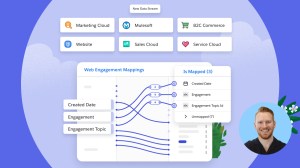Editor’s note: Einstein 1 Platform is now the Salesforce Platform. For the latest, go here.
Salesforce recently announced its Zero Copy Partner Network, which allows businesses to easily connect Data Cloud to external data platforms without the hassle of duplicating data and managing other datasets.
We spoke with Tyler Carlson, VP of Business Development & Strategy, about why zero copy data access (ZCDA) is so important for creating a full understanding of a business’s customers and how the new Zero Copy Partner Network can help organizations glean insights from their data — whether it’s stored in Salesforce or somewhere else.
Q. What is zero copy?
Zero copy integration gives applications access to different external databases without the need to move, copy, or reformat any of that data.
Salesforce pioneered zero copy technology at the application layer because we recognized that many of our customers have data in diverse places — like applications, data lakes, and data warehouses — outside the Salesforce ecosystem.
Traditionally, if a business wanted to bring data from a data warehouse like Snowflake to Salesforce to do something like use generative AI to create an email grounded in customer data, it would’ve had to move that data to Salesforce first. That requires copying the data, creating an extract pipeline for extracting that data into Salesforce, and then keeping that data up-to-date on a synchronous basis.
For most, that simply didn’t work. Many of the business and IT leaders I speak with say they want a holistic customer view, but they don’t want the headache of duplicating data from every platform to achieve it. With zero copy integrations, our customers can access data so that data can be used across the Salesforce Einstein 1 Platform where it lives, without copying anything.
With zero copy integrations, our customers can access data so that data can be used across the Salesforce Einstein 1 Platform where it lives, without copying anything.
Tyler Carlson, VP of Business Development & Strategy
Q. Why is zero copy important for businesses?
Businesses have a wealth of data sitting in data lakes and data warehouses — like email open rates, financial data, customer interactions, and product catalogs. The problem is: that data is there mostly for analytical purposes. It’s not available to business users — the sales teams, service teams, marketing teams — who need that data in their flow of work in apps like Sales Cloud, Service Cloud, or Marketing Cloud.
Without zero copy, businesses had to copy that data and load it into Data Cloud to know what their customers were doing across every engagement with their brand.
But copying data creates a ton of issues. Once you’ve duplicated the data, you have to manage it: keep it in sync with the latest data from that external platform, direct ETL (extract, transform, load) processes and data pipelines between platforms, and institute new security and governance rules over copied data. It’s a costly, time-consuming, and ongoing process.
Zero copy integration solves that. There are no extraction and load pipelines to maintain. It’s always synchronized. And it’s more secure — because your data stays in place.
Q. What is the Zero Copy Partner Network and how does it work?
The Zero Copy Partner Network includes partners that are committed to zero copy integrations with Salesforce, giving joint customers a secure and cost-effective way to connect and take action on all of their data.
These integrations are also a two-way street — what’s called “bidirectional.” Data doesn’t just flow one-way into Salesforce, the rich customer data in Salesforce is also available to members of the partner network. Partners include Amazon Web Services (AWS), Databricks, Google Cloud, IBM, Microsoft, and Snowflake.
We’re also expanding this network to a broader ecosystem of partners, including data providers and Software as a Service (SaaS) applications to enable them to do zero copy integrations.
Our independent software vendors (ISVs) and system integrators (SIs) are also core to the Zero Copy Partner Network. ISVs are going to build amazing applications that will provide zero copy customers with third-party datasets from companies like Moody’s, The Weather Company, and Workday.
SIs will also play a huge role in the Zero Copy Partner Network, lending their expertise to help customers unlock their trapped data via zero copy integrations.
Q. How is the Zero Copy Partner Network related to Data Cloud?
Data Cloud helps businesses unify all their customer data — both structured and unstructured — into a 360-degree view of their customer in Salesforce.
Data Cloud helps businesses unify all their customer data — both structured and unstructured — into a 360-degree view of their customer in Salesforce.
Tyler Carlson, VP of Business Development & Strategy
Making that data useful in the flow of work and enabling things like AI capabilities requires bringing data together from across a bunch of disparate systems. Many of our customers have data that’s locked in their applications or data platforms, and they want to bring it together and harmonize it for a full view of their customers.
Zero copy lets businesses work with data from external sources without having to copy it into Salesforce first. It does this by creating a ‘pointer’ that tells Data Cloud where to find the source data when it’s needed.
Q. How does Salesforce’s approach to metadata facilitate zero copy?
The great thing about the Zero Copy Partner Network is that most customers already have a head start on preparing their data for it. When they proceed to set up their zero copy integration, they’re just creating the metadata in Data Cloud that tells Salesforce where it lives, how to find it, and how to read it. In this situation, metadata is like a translator that allows data from different systems or sources to speak the same language. It’s the key to Data Cloud understanding and harmonizing it with other customer data.
The great thing about the Zero Copy Partner Network is that most customers already have a head start on preparing their data for it.
Tyler Carlson, VP of Business Development & Strategy
Q. How does zero copy support Salesforce’s AI strategy?
Our AI strategy is fueled by unlocking customer data and metadata, and we recognize a lot of that lives outside of Salesforce.
Our zero copy approach relies on an “open table format,” or a method of standardizing and defining datatables. This open approach is key to creating a network of data partners that will help our customers expand access to all of that data from the applications they use every day. That’s how we bring our AI strategy to life.
The Zero Copy Partner Network is key to this strategy. It allows more of a business’s trapped data from across their organization to be available within Salesforce to power generative and predictive AI use cases. Without unlocking that data, it becomes really challenging to create a unified customer profile and get the most value out of their AI investments.
That’s the most exciting thing about this innovation to me. Our strategy has always been to be open and extensible, so zero copy is bringing to fruition the data and AI strategy that we’ve been working on for years. It’s truly now providing unique value to all of our shared customers — both the customers that use zero copy and all the members of our partner network.
Go deeper:
- Learn more about how zero copy can help businesses save time and money
- See who’s in Salesforce’s Zero Copy Partner Network here and here
- Get Data Cloud to start taking action on your data now

















